| Reviews & Columns |
|
Reviews DVD TV on DVD Blu-ray 4K UHD International DVDs In Theaters Reviews by Studio Video Games Features Collector Series DVDs Easter Egg Database Interviews DVD Talk Radio Feature Articles Columns Anime Talk DVD Savant Horror DVDs The M.O.D. Squad Art House HD Talk Silent DVD
|
DVD Talk Forum |
|
|
| Resources |
|
DVD Price Search Customer Service #'s RCE Info Links |
|
Columns
|
|
|
Hell In The Pacific (1968)
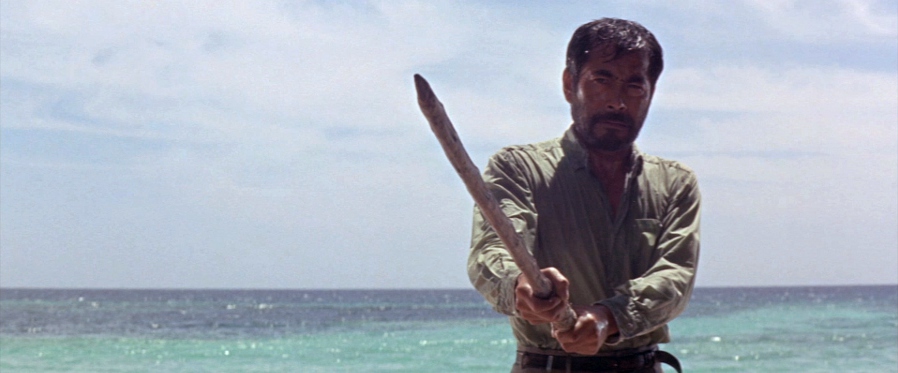 Featuring just two characters, almost no dialogue, and even less plot exposition, John Boorman's early career highlight Hell in the Pacific (1968) has aged exceptionally well during the last five decades. This WWII drama stars Lee Marvin and Toshiro Mifune as unnamed servicemen marooned on a deserted island who, not surprisingly, spend at least half of their shared time fighting one another. Like Frank Sinatra's None But the Brave, the similarly themed Hell in the Pacific attempts to piece together rickety Japanese-American relations decades after the war ended. It does so in a much more symbolic, thoughtful, and realistic manner, reminding us that bonds can always be formed under the right circumstances...and just as easily broken, even without a large bottle of sake. Naturally, a large part of Hell in the Pacific's on-screen culture clash is due to the language barrier, as any threatening body language or tone often creates friction that may not have existed otherwise. Interestingly enough, director John Boorman---who made his Hollywood debut with the great Point Blank, also starring Marvin, a year earlier---insisted on not subtitling Mifune's Japanese speech during the film's theatrical run, thrusting viewers into the same situation as their stranded American representative. (It's unclear whether or not the opposite was true in Japanese theaters). Though an interesting experiment, this decision ultimately robs Mifune's character of some much-needed clarity during critical moments and, in my opinion, makes the film too partisan. MGM's 2004 DVD (as well as Kino's new Blu-ray) changed all that, providing optional subtitles that finally allowed non-Japanese speakers to understand both sides of the story. But if you want the original experience, just turn them off and see how it affects your ability to empathize. Unfortunately, the theatrical cut of Hell in the Pacific was almost completely ruined due to a last-minute ending change by the film's producers, who tacked on a shot from Blake Edwards' The Party (released earlier that year) without telling Boorman in advance. Luckily, the more realistic and tonally consistent original ending survived and was even included on MGM's 2004 DVD as an extra, albeit in rough condition. Kino's Blu-ray serves up a new 1080p transfer of the film with an option to finally watch the restored original ending via seamless branching, which goes a long way towards letting us reevaluate Hell in the Pacific on its own terms. Several new extras, including a recent interview with Boorman, were also created for this most welcome catalog release.
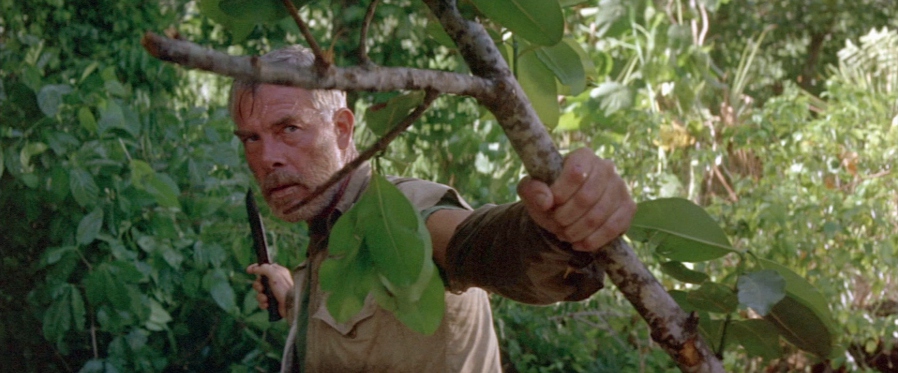
Presented in its original 2.35:1 aspect ratio, this new 1080p transfer of Hell in the Pacific represents a solid upgrade over MGM's non-anamorphic (!) 2004 DVD. This is a beautifully shot film as DVD Savant notes in his review, full of lush outdoor cinematography by Conrad L. Hall (In Cold Blood), so it obviously looks stronger than ever in high definition: colors, image detail, and texture benefit dramatically at times, while black levels and contrast are quite well defined during brighter moments. There are still a number of trouble spots, however: scenes shot in low light have limited shadow detail, with black levels that are more medium-gray and look quite noisy at times. It's unknown whether or not this is a source material issue, but the bulk of what's here looks fantastic. Either way, Hell in the Pacific has been long overdue for a visual upgrade and die-hard fans should be pleased overall.
This Blu-ray's DTS-HD Master Audio mix is presented in a split 2.0 mono spread with clear dialogue and sound effects; I've been told that a four-track audio mix exists, but perhaps it was not available or in poor condition. Though obviously limited by its source material in some respects, this is still a very competent presentation that conveys a desolate atmosphere as well as can be expected. The sea-faring scenes during its second half are quite powerful at times. Dynamic range is decent enough under the circumstances and Lalo Schifrin's score makes its presence known, but a handful of slight volume fluctuations might have you reaching for the remote every so often. Optional English SDH subtitles are included during the film, which also translate Mifune's Japanese speech (as explained earlier, this was avoided theatrically at the director's request, but the 2004 DVD covered both languages as well).
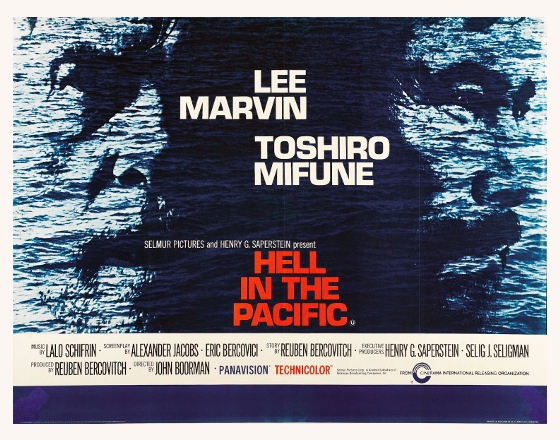 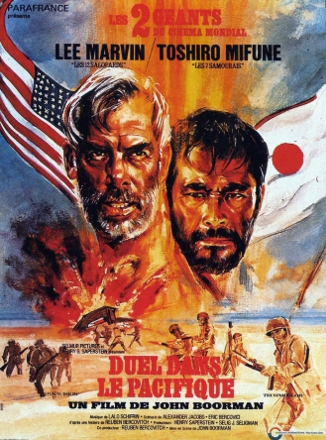
On the same subject, Hell in the Pacific's excellent Alternate Ending (2 minutes) has now been fully restored in 1080p and matches the rest of the film in terms of A/V quality. What's more is that it's presented via seamless branching---this is a big plus, as it offers a substantial improvement over the theatrical cut and represents the director's preferred version. Keeping those smooth segues rolling, we also get two brand new Interviews with key crew members. Director John Boorman (33 minutes) provides a wealth of first-hand knowledge about the film: some topics include location scouting in the Pacfic, working with Mifune and a mostly Japanese crew, tsunami waves and an unlikely injury, working towards an ending, speaking with Akira Kurosawa, Lee Marvin's experience on set, a free meal at Mifune's restaurant in Japan, the last-minute ending change, and several other items of interest. Art director Anthony Pratt (11 minutes) speaks about his initial meeting with Boorman, living on a boat during production, difficult weather conditions, Conrad Hall's contributions, and more. As with the alternate ending and audio commentary, these new interviews deepened my appreciation for this already-great film and give Kino's Blu-ray a lot of added value.
Featuring two powerhouse lead actors and their surprisingly low-key performances, John Boorman's early career highlight Hell in the Pacific plays perfectly well almost 50 years later thanks to its universal themes, limited dialogue, and memorable characters. Not far behind are Conrad L. Hall's lush cinematography and Lalo Schifrin's score which, combined with the exotic locale, really help to enhance the story's magnetic atmosphere. Kino's new Blu-ray offers ample support for the main feature with a solid A/V upgrade and several new bonus features (including the director's original ending, newly restored in HD and now available via seamless branching), all of which deepened my appreciation for this already-great film. What could've been a fairly soft upgrade turned out to be one of this year's most surprisingly well-rounded and thoughtful catalog releases. Highly Recommended to fans and first-timers alike.
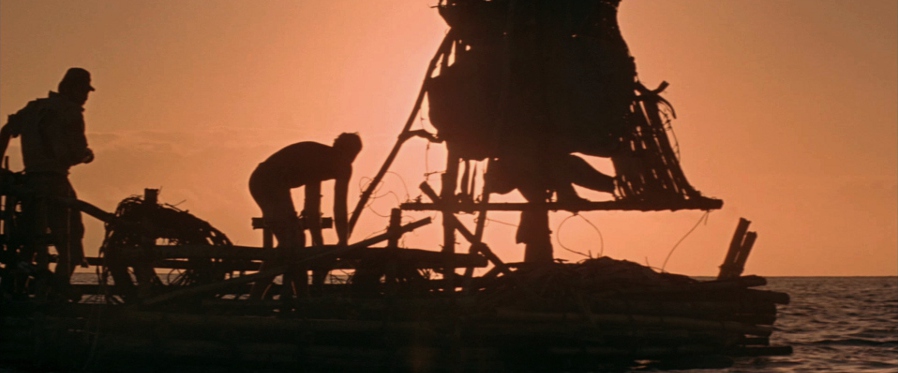 |
|
| Popular Reviews |
| Sponsored Links |
|
|
| Sponsored Links |
|
|
| Release List | Reviews | Shop | Newsletter | Forum | DVD Giveaways | Blu-Ray | Advertise |
|
Copyright 2024 DVDTalk.com All Rights Reserved. Legal Info, Privacy Policy, Terms of Use,
Manage Preferences,
Your Privacy Choices | |||||||













